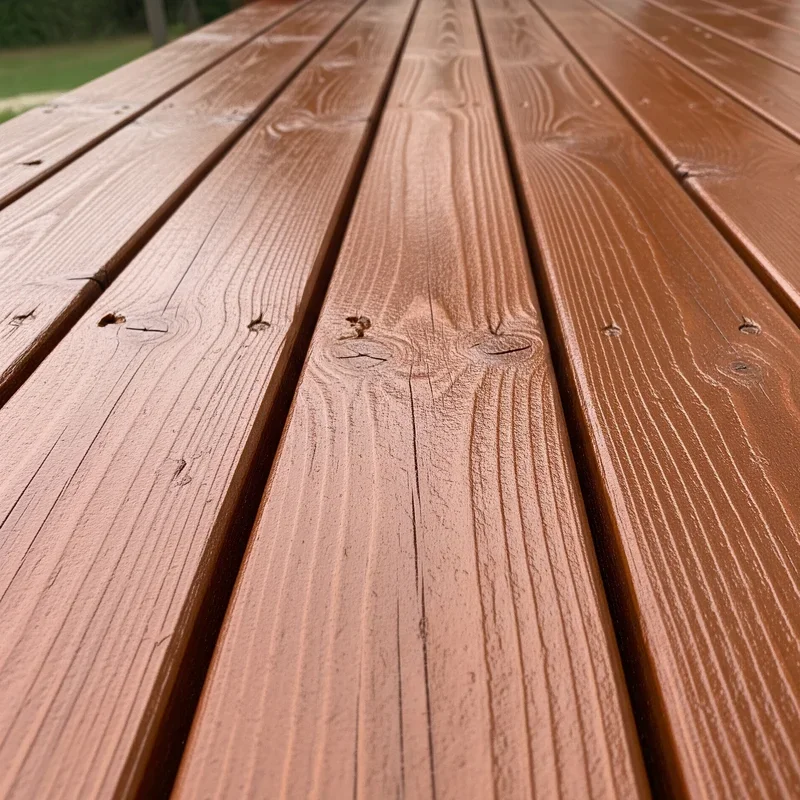How Long for Deck Stain to Dry Before Use or Sealing
Wondering how long for deck stain to dry before use or sealing? Get expert timing tips, weather factors, and drying guidelines for perfect results.
Well, you've finally done it! After hours of sanding, cleaning, and carefully applying that gorgeous deck stain, you're probably itching to throw a barbecue and show off your handiwork. But hold your horses! Jumping the gun on using your newly stained deck can turn your weekend project into a sticky mess faster than you can say "outdoor entertainment."
Understanding exactly how long for deck stain to dry before use or sealing isn't just about patience; it's about protecting your investment and ensuring that beautiful finish lasts for years to come. Whether you're a DIY enthusiast tackling your first deck project or a seasoned pro looking for a refresher, knowing the ins and outs of drying times can make or break your results.
Understanding the Basics of Deck Stain Drying
Before we dive into specific timeframes, let's get our heads around what actually happens when deck stain dries. You see, it's not just about the surface feeling dry to the touch. There's a whole chemical process happening beneath that pretty exterior.
When you apply deck stain, you're essentially asking the wood to absorb a cocktail of pigments, oils, and solvents. As these components settle in, the solvents need to evaporate completely, allowing the protective elements to cure properly. Think of it like baking a cake; just because the top looks done doesn't mean the center's ready!
The Three Stages of Drying
Believe it or not, your deck stain goes through multiple personality changes before it's fully cured:
Surface Dry: This happens pretty quickly, usually within 1-4 hours
Touch Dry: You can gently touch it without leaving marks (4-8 hours)
Fully Cured: The stain has completely bonded with the wood (24-72 hours or more)
Factors That Affect How Long for Deck Stain to Dry Before Use or Sealing
Now here's where things get interesting! Mother Nature loves to throw curveballs when you're trying to stain your deck. Several factors can speed up or slow down your drying time significantly.
Weather Conditions Make All the Difference
Temperature plays a huge role in drying times. If you're staining in ideal conditions (around 70°F with low humidity), you're golden! But staining on a humid day in Florida? That's a whole different ball game. High humidity can double or even triple your waiting time.
Wind can be both friend and foe. A gentle breeze helps evaporation, but too much wind might blow debris onto your wet stain. Talk about frustrating!
Type of Stain Matters More Than You Think
Not all stains are created equal, folks! Here's the breakdown:
Water-based stains: These speedsters typically dry in 2-4 hours
Oil-based stains: The marathon runners, taking 24-48 hours
Gel stains: Somewhere in between, usually 8-24 hours
Semi-transparent vs. solid stains: Thicker applications need more time
Wood Type and Condition
Hardwoods and softwoods absorb stain differently. Pine, being a softwood, drinks up stain like a thirsty teenager with a soda. Meanwhile, hardwoods like mahogany take their sweet time. Previously stained or sealed wood? Add extra drying time to your schedule.
Standard Drying Times for Different Scenarios
Alright, let's get down to brass tacks with some real numbers you can work with.
How Long Before Light Foot Traffic?
For most water-based stains, you're looking at 4-6 hours before tiptoeing across your deck is safe. Oil-based stains? Better wait a full 24 hours minimum. Though honestly, if you can wait 48 hours, your deck will thank you for it.
When Can You Move Furniture Back?
Here's where patience really becomes a virtue. Even with quick-drying water-based stains, waiting 24-48 hours before dragging that heavy patio set back is wise. For oil-based products, give it at least 72 hours. Those chair legs can leave permanent marks in stain that hasn't fully cured!
How Long for Deck Stain to Dry Before Sealing?
If you're planning to add a sealer on top of your stain, timing is everything. Water-based stains typically need 24-48 hours before sealing. Oil-based stains require more patience; wait at least 72 hours, though a full week is even better. Rushing this step is like putting icing on a warm cake; it'll just slide right off!
Temperature and Humidity Guidelines
Let's talk numbers that actually matter for your project's success.
Ideal Conditions for Staining
The sweet spot for deck staining sits between 50°F and 90°F. But here's the kicker: it's not just about the temperature when you're applying the stain. You need those temperatures to stay consistent for at least 48 hours after application.
Humidity should ideally be below 50%. Anything above 70% humidity, and you might as well be trying to dry your deck underwater! On super humid days, adding an extra 24-48 hours to your drying time isn't being overly cautious; it's being smart.
Seasonal Considerations
Spring and fall often provide the best staining conditions. Summer can work too, but avoid those scorching hot days when the stain might dry too quickly on the surface while staying wet underneath. Winter staining? Unless you live somewhere with mild winters, just don't. Cold temperatures can prevent proper curing altogether.
Testing Your Deck for Dryness
Now, how do you actually know when your deck's ready for action? There are several reliable methods to check.
The Touch Test
Gently press your finger on an inconspicuous area. If it feels tacky or leaves a fingerprint, it needs more time. Simple as that!
The Water Drop Test
After the recommended drying time, sprinkle a few water drops on the surface. If they bead up, you're good to go. If they soak in immediately, your stain might need another coat.
The Tape Test
Stick a piece of painter's tape on the deck and pull it off quickly. Any stain on the tape means more waiting time's needed.
Common Mistakes That Extend Drying Time
Boy, have I seen some doozies over the years! Here are the big no-nos that'll have you waiting forever for your deck to dry:
Applying stain too thick: More isn't always better, folks
Staining in direct sunlight: Causes uneven drying and lap marks
Ignoring weather forecasts: Rain within 24 hours of staining spells disaster
Not properly preparing the wood: Dirty or damp wood won't absorb stain properly
Using old or improperly stored stain: It might never dry correctly
Tips for Faster Drying
Patience wearing thin? Here are some legitimate ways to speed things up without compromising quality:
Choose water-based stains for quicker turnaround
Apply thin, even coats rather than one thick layer
Stain during optimal weather conditions
Ensure proper ventilation around your deck
Use a moisture meter to check wood moisture content before starting
Consider using a stain with built-in drying accelerators
What Happens If You Use Your Deck Too Soon?
Getting antsy and using your deck before it's ready can lead to:
Permanent footprints and furniture marks
Peeling and flaking stain
Uneven color and blotchy appearance
Reduced lifespan of the stain job
Need for complete redo (ouch!)
Trust me, waiting those extra hours or days beats having to strip everything and start over!
Special Considerations for Different Deck Materials
Pressure-Treated Wood
This stuff's tricky because it often contains moisture from the treatment process. Brand new pressure-treated lumber might need several weeks to dry before staining. The old "sprinkle test" works great here; if water soaks in, you're ready to stain.
Cedar and Redwood
These naturally weather-resistant woods are stain-friendly but can be finicky. They often have natural oils that can interfere with drying times. Expect to add 12-24 hours to standard drying times.
Composite Decking
If you're staining composite decking (yes, some types can be stained!), follow manufacturer guidelines religiously. These materials often have specific requirements that differ from natural wood.
Professional vs. DIY: Timing Differences
Pros often have access to commercial-grade stains that dry faster and more predictably. They also know tricks like using fans or heaters (carefully!) to control drying conditions. But here's the thing: even pros respect drying times. If a "professional" tells you they can stain your deck and have it party-ready the same day, run for the hills!
Maintenance and Long-Term Care
Once your deck's properly dried and cured, maintaining it properly extends the time between restaining projects. Regular cleaning, prompt attention to spills, and annual inspections keep your deck looking fresh. Most quality stain jobs last 2-3 years on horizontal surfaces and 4-5 years on vertical surfaces.
Conclusion
Getting the timing right for your deck stain to dry isn't rocket science, but it does require patience and attention to detail. Whether you're working with water-based or oil-based products, respecting proper drying times ensures your hard work pays off with a beautiful, long-lasting finish. Remember, good things come to those who wait, and that gorgeous deck you've been dreaming about is definitely worth a few extra days of patience!
Read next: 15 Deck Stairs Ideas to Upgrade Your Backyard Look
Frequently Asked Questions
Q1: Can I stain my deck if rain is expected?
A: No, you need at least 24-48 hours of dry weather after staining.
Q2: What's the minimum temperature for staining a deck?
A: Most stains require temperatures above 50°F for proper drying and curing.
Q3: How long should I wait between stain coats?
A: Typically 2-4 hours for water-based and 24 hours for oil-based stains.
Q4: Can direct sunlight speed up drying time?
A: Actually, it can cause uneven drying and should be avoided during application.
Q5: Is it okay to stain a damp deck?
A: Never stain damp wood; it prevents proper absorption and adhesion completely.




















